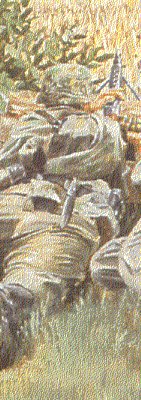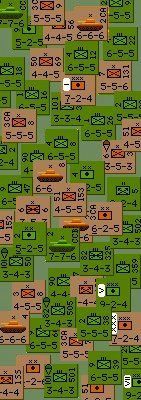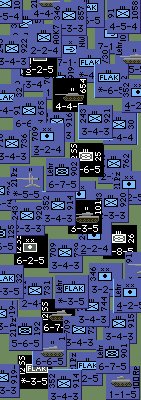
As in most good games, victory in Breakout: Normandy requires a combination of skill and luck. Skill is very important, no doubt about it, but so is good fortune. In this respect, the game is somewhat like baseball: a good player can expect to win only 60-70% of his games in the long haul, due to the uncontrollable chance element. It can be very frustrating when good play is trumped by your opponent's incredibly strong dice, or even more so when your own bad dice are the source of the problem.
It is sometimes argued that the chance element is a bit too big in Breakout: Normandy. Seldom, if ever, is it said that the role of chance is not great enough. While luck enters into the game in other ways as well, the most important channel is via the DR Diff, which has a 'normal' probability distribution. In principle, one could play the game with a tighter normal distribution -- one with a smaller variance -- and thereby address any concerns about the role of luck being too great. To my knowledge this has never been done in practice.
Below you will find several tables. They quantify the chance element in this game. A good player will know these tables well, not to the last decimal place but certainly in a general way. Decision-making within Breakout: Normandy requires that the chance element be balanced against the potential gains and losses, and this requires a deep understanding of the probability element.
Table P.1 -- DR Sum Probabilities. In Breakout: Normandy, many outcomes are decided by simultaneously rolling two dice (that is, by a DR). The Sunset DR is a good example. This table shows the probability of getting any given sum as the result of a DR. The table also shows the probability of getting a DR result that is less than or equal to any one of the eleven possible sum values (2, 3, ..., 12).
Table P.2 -- DR Difference Probabilities. In Breakout: Normandy, the outcomes of assaults and bombardments are decided by simultaneously rolling two pairs of dice (two DRs) and calculating the difference between their sums (that is, by a DR DIFF). This table shows the probability of getting any given DR DIFF as the result of rolling two pairs of dice. The table also shows the probability of getting a DR DIFF result that is less than or equal to, or greater than or equal to, any one of the 21 possible DR DIFF values (-10, -9, ..., 9, 10). I am grateful to Mircea Pauca for pointing out some errors in an earlier version of this table.
Table P.3 -- Inflicting a Given Number of CPs/APs. In Breakout: Normandy, the number of Casualty Points (CPs) inflicted in a given assault, or the number of Attrition Points (APs) inflicted in a given bombardment, depends partly on the AV-DV difference that is calculated prior to rolling the dice, and partly on the DR DIFF result that comes from rolling two pairs of dice. This table shows the probability of inflicting any given number of CPs/APs or more, given a particular AV-DV difference (prior to rolling the two pairs of dice). I am grateful to Mircea Pauca for pointing out some errors in an earlier version of this table.
Table P.4 -- Sunset and Weather Changes. In Breakout: Normandy, a Sunset DR is made at the end of every impulse to determine whether the sun sets (the day ends) -- which occurs if the Sunset DR is less than the current impulse number -- and whether the weather changes -- which occurs if the Sunset DR is equal to the current impulse number. This table shows how the probability of these occurrences varies according to the current impulse number.


